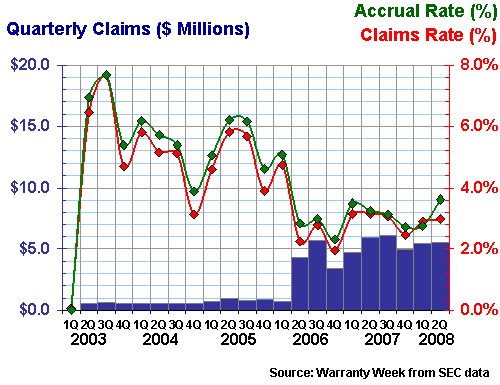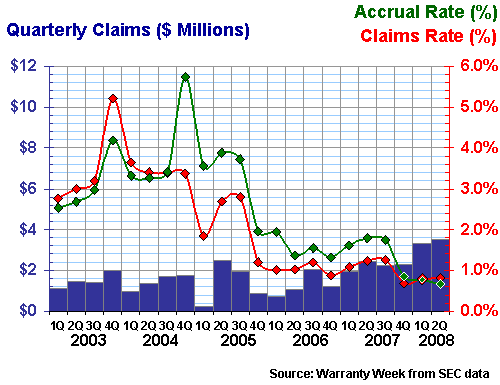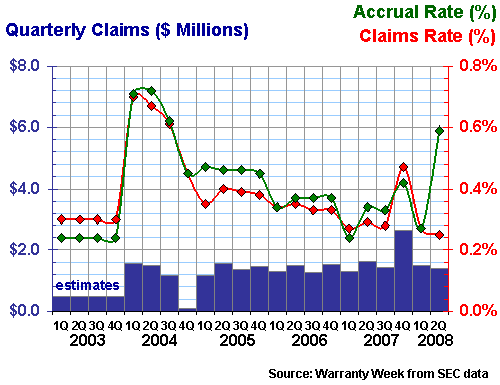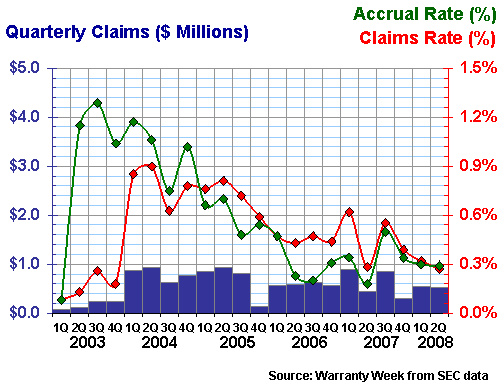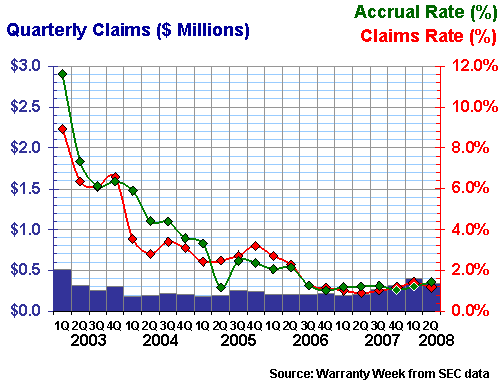Medical Equipment Warranties:While claims are increasing, sales are rising a little faster in the medical and scientific equipment industries. And at least eight companies have cut their warranty expenses by big percentages over the past five years.
Times are tough in the medical equipment and scientific instrument industries. After falling in the first half of 2006 and again in the first half of 2007, claims paid during the first half of 2008 are up by 8.3% to the $343 million level.
As a percentage of sales, however, the 93 companies tracked in these categories by Warranty Week actually paid out a bit less in the first half of 2008 than they did in the first half of 2007. Their collective claims rate in June 2008 was 0.72%, down just a notch from 0.73% in June 2007, thanks to the effects of a healthy rise in sales. Accruals were up, however, from 1.5% to 1.6%, and that can't be blamed on changes in sales volume.
Though there tends to be many manufacturers in the medical and scientific industries, most of those reporting warranty costs tend to be either small or medium-sized. When Warranty Week last took a detailed look at these segments (in the newsletter of Sept. 13, 2005), we profiled ten of the largest.
In this issue, we selected eight companies to profile. But rather than choosing them on the size of their warranty budgets, we chose eight that have turned in steadily declining warranty costs over most of the past five years. With all the recent bad news for manufacturers and financial companies, we thought it might be a good time to find something positive to report.
So here's some good news: 59 of the 93 companies saw sales increases from the first half of 2007 to the first half of 2008, and only 36 saw their warranty claims rate rise during the same period. Because the claims rate is computed by dividing sales into claims, however, a rise in sales can in and of itself cause a drop in the claims rate, even if actual spending also rose.
Only 39 increased their accrual rates from June 2007 to June 2008, although seven of those -- American Science and Engineering Inc.; Aspect Medical Systems Inc.; Boston Scientific Corp.; Cambridge Heart Inc.; Cepheid; Hutchinson Technology Inc.; and Paragon Technologies Inc. -- had to more than double their accrual rates to keep pace with the rise in payouts. This suggests either a radical change in the product line or a massive problem with product quality. At the other extreme, 11 companies cut their accrual rate by half or more.
Dental Warranties
Sirona Dental Systems manufactures dental CAD/CAM systems, x-ray imaging systems, dentist chairs, and instruments. The company traces its roots back to 1882, when a German company called Reiniger, Gebbert & Schall introduced the first electrical drill machine. The company was acquired by Siemens in 1925, and was spun off in 1997 in a leveraged buy-out. The company was then acquired by a Scandinavian company in 2004 and then by a private equity firm in 2005.
Meanwhile, there was an American medical equipment company that was operating as Schick Technologies Inc. from 1992 onwards. In June 2006, Schick acquired Sirona from its owners, and renamed itself Sirona Dental Systems Inc. Its headquarters is in Long Island City, New York, while the primary manufacturing and assembly facilities are in Bensheim, Germany, south of Frankfurt. Subsidiaries operate in 10 more countries, with representative offices in dozens more.
In Figure 1, it's pretty clear that the date of the most recent acquisition fell into the second quarter of 2006. Before then, Schick was paying out less than $1 million per quarter in warranty claims, which at the time was between 4% and 8% of its overall revenue.
Post-acquisition, claims shot up to a range of $4 to $6 million per quarter, but because of all the additional revenue, the claims rate fell to between 2% and 4% of revenue. It's almost as if there were two different companies.
The company's claims rate in June of this year stood at 3.0%, down roughly two-tenths of a point from a year before, while its accrual rate stood at 3.6%, up almost half a point from a year ago. Warranty reserves, at $15 million in June, were up $2 million from a year before.
Figure 1
Sirona Dental Systems Inc.
Warranty Claims & Accrual Rates, 2003-2008
(in $ Mil & percentage of product sales)
Hologic Inc. also specializes in x-ray imaging systems, but its products are aimed at osteoporosis, mammography, and other applications related to women's health. The company is now working on advanced three-dimensional imaging systems that promise to help doctors increase the breast cancer detection rate and decrease the number of false positives.
In warranty terms, Hologic is now enjoying incredibly low claims and accrual rates after years in which costs were 3%, 4%, and even occasionally more than 5% of product revenue. At times, increased warranty costs took the blame for reduced profits and even net losses. Now, the company has little to say about it.
The claims rate in the current fiscal year is down by more than a third compared to a year before, while the accrual rate is down by almost two-thirds. The warranty reserve over the past year has contracted by $1 million to the $11 million level as of June 2008.
Figure 2
Hologic Inc.
Warranty Claims & Accrual Rates, 2003-2008
(in $ Mil & percentage of product sales)
Roper Industries is only partially a medical equipment company, with other units engaged in activities as diverse as automatic meter recording and network monitoring for utilities, highway toll collection systems for states, and industrial pumps. More than half the company's $2.1 billion in annual revenue, in fact, comes from operations it acquired within the past five years.
Back in 2003, the company provided only annual warranty cost figures, which is why we had to estimate the quarterly amounts in Figure 3 below. In 2004 Roper began updating its warranty costs quarterly, and those costs immediately began to rise. From 0.2% to 0.3% in 2003, costs more than doubled to the 0.7% level in early 2004.
Supplier Problems
Then warranty costs began to fall. And they kept falling, back down to 2003 levels in 2006, then below those levels for at least parts of 2007. If our story ended there, we'd say the company had successfully absorbed its acquisitions and was "back to normal" in terms of warranty costs. However, in the past nine months, first the claims rate and then the accrual rate suddenly jumped, and now it's apparent that not all is well. The company said the recent increase is due to a special $3.5 million warranty charge at its Neptune unit, related to a certain vendor-supplied component used in select water meters which were causing a malfunction.
Roper's latest claims rate is slightly below a year ago's level, but its accrual rate is up from 0.3% to 0.6%. The warranty reserve fund has also grown appreciably in size, adding $4 million to drive its balance up to $12 million by the end of June.
Figure 3
Roper Industries Inc.
Warranty Claims & Accrual Rates, 2003-2008
(in $ Mil & percentage of product sales)
Conmed Corp. got its start 30 years ago in upstate New York, manufacturing electrodes for electrocardiograms. Since then, it's branched out to the manufacture of a wide variety of surgical instruments, supplies, fluid management, knee replacement, and heart monitoring equipment.
Recent product introductions have integrated both high definition televisions and touch screen computers into the systems. Brand names include Conmed, Linvatec, and Hall Surgical. Manufacturing is conducted in Mexico, Finland, and the U.S., with headquarters remaining in Utica NY. Warranties are typically for one year.
In Figure 4, except for that 18-month detour in 2006 and the first half of 2007, Conmed's warranty costs have been constantly headed downwards. When the company began reporting its warranty expenses in 2003, claims consumed 0.9% of revenue and accruals stood at 1%. By 2008, both measures were below 0.4%. Conmed has also found reason to cut its warranty reserve by half a million dollars to its current $3.1 million level.
Figure 4
Conmed Corp.
Warranty Claims & Accrual Rates, 2003-2008
(in $ Mil & percentage of product sales)
Mentor Corp. specializes in breast implants, as well as liposuction and botox treatments. Bet you didn't know those come with warranties. But with all the post-surgical problems the industry has suffered in recent years, it should come as no surprise that mentor's warranty costs were once at the same elevated levels seen by computer manufacturers and automakers. In fact, Mentor has said that competitive pressures were behind its early 2007 move to enhance its warranties. They even now sell extended warranties for $100.
Back in those bad old days of 2003 and 2004, when recalls and lawsuits plagued the industry, Mentor regularly maintained a warranty reserve sized in the range of $20 to $25 million. By June 2008, that balance had been allowed to decline to only $12 million. In the first quarter of 2008, thanks to "updated actuarial data," Mentor removed $3.7 million from the reserve through a downward change of estimate.
In the past year, Mentor has cut its warranty accrual rate from 1.5% to 1.0% of its "breast aesthetics" revenue stream. During 2005 and half of 2006 it was closer to 3% of revenue. Claims, meanwhile, have sloped downward from the 2% range to their current slot just under 1%. Although the claims rate has fallen only 0.1% in the past year to 0.7%, it is clear in Figure 5 that it was much higher two or three years ago.
Figure 5
Mentor Corp.
Warranty Claims & Accrual Rates, 2003-2008
(in $ Mil & percentage of product sales)
Idexx Laboratories specializes in veterinary medical products. And that's not just for household pets. The company has a whole product line just for horses, and another aimed at poultry. It also sells kits used for the testing and safety of milk and water supplies.
Though Figure 6 shows a rough beginning for warranty costs in 2003, it's equally clear that ever since it's been all downhill. After peaking at 1.3%, the company's accrual rate has steadily declined, reaching a low of 0.2% by June 2007. It's now at 0.3%, which on paper equates to a 58% annual rise in the past year.
Warranty reserves have more or less kept pace, declining from the $5 million level in 2004 to the $3 million level in early 2006 and the $1.6 million level by June 2008. The decline in just the past year has been almost 10%.
Claims, meanwhile, peaked at 0.9% of product revenue in early 2004, before falling below 0.3% in June 2007, and again in June 2008. Year-over-year, the claims rate shows only a slight decline, but the five-year picture seen in Figure 6 tells a different story.
Figure 6
Idexx Laboratories Inc.
Warranty Claims & Accrual Rates, 2003-2008
(in $ Mil & percentage of product sales)
Cantel Medical specializes in kidney dialysis machines and supplies, and also has product lines aimed at dental and water purification applications. Its five-year track record in the reduction of warranty expenses is stellar, having reduced both claims and accruals from unsustainable levels to a much more manageable sub-2% level.
Compared to a year ago, however, the trend is upwards. In the middle of 2007, claims stood at 0.9% of product revenue while accruals stood at 1.2%. By the middle of 2008, the claims rate was 1.2% and the accrual rate was 1.4%. The scale of the chart in Figure 7, however, is so wide that these recent increases are somewhat obscured.
Cantel made four significant acquisitions in 2007, and it's possible that the integration of those units into the fold caused some of the recent rise. But compared to the 9%-to-12% levels seen in 2003, those changes are nothing more than rounding errors.
Figure 7
Cantel Medical Corp.
Warranty Claims & Accrual Rates, 2003-2008
(in $ Mil & percentage of product sales)
Finally, we wanted to spotlight one more small medical company, called Palomar Medical Technologies. But this one is more of a consumer products company, specializing in systems and machines aimed at removing unwanted hair and reversing skin aging. These applications carry the company deep into the laser industry, which in part explains the higher-than-typical warranty costs detailed in Figure 8.
Palomar Medical has enjoyed the twin blessings of declining warranty costs and increasing product sales for most of the past five years. Sales during the first half of 2008, however, were down by more than a third, which helps explain the recent rises.
Figure 8
Palomar Medical Technologies Inc.
Warranty Claims & Accrual Rates, 2003-2008
(in $ Mil & percentage of product sales)
Palomar's claims rate has risen by 0.4% in the past year to 2.2%. The accrual rate, however, is down by 0.7% to 1.6% of product revenue. The claims rate is more affected by changes in sales volumes than the accrual rate, however. The accrual rate should always remain proportional to sales, unless product quality is also changing.
That having been said, there was clearly a warranty episode of some sort during the third quarter of last year. Claims rose by 62% and the claims rate soared from 1.8% to 3.5%. But whatever it was, it was also an anomaly. By the end of 2007, both claims and accrual rates were back down around 2.1%.
| 


